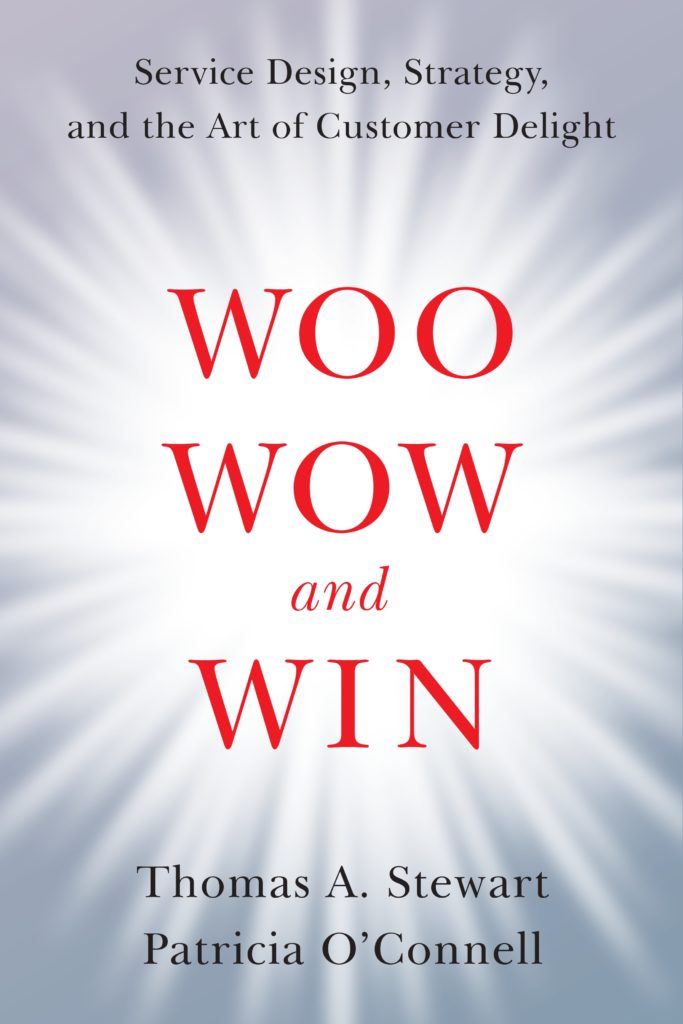MRM Talking With: Patricia O’Connell and Thomas A. Stewart, Authors of ‘Woo, Wow, and Win’
7 Min Read By MRM Staff
In this latest edition of MRM “Talking With” Modern Restaurant Management magazine discusses service design and customer delight with Patricia O’Connell (POC) and Thomas A. Stewart (TAS), authors of the just-released “Woo, Wow, and Win: Service Design, Strategy, and the Art of Customer Delight.” Stewart is a best-selling author, an authority on intellectual capital and knowledge management, and a thought leader on global management issues and ideas. He is also the Executive Director of the National Center for the Middle Market of the Fisher College of Business at The Ohio State University, and has served as Chief Marketing and Knowledge Officer for Booz & Company, as well as editor and managing director of Harvard Business Review. O’Connell is a New York City-based writer and editor specializing in business, leadership, and strategy. She is the writer, with author Neil Smith, of the New York Times bestseller “How Excellent Companies Avoid Dumb Things.”
In “Woo, Wow and Win,” the authors apply the principles of design and show how reimagining, recreating, and rethinking the execution of every stage and aspect of company interactions—regardless of what is being sold—not only satisfies customers but advances a business’s strategic goals.
For more information on the book, click here.

Where did the impetus come from to write this book and what was the process like?
POC: A visit to the Savannah College of Art and Design and a conversation with the Dean of the Design School, Victor Ermoli, was my first exposure to the concept of service design – that there are steps companies can take to ensure a positive emotional connection between themselves and their customers, not just by training employees but by designing the experience to make a good result inevitable.
Superior service needs to be designed into a business, not slapped on at the end.
TAS: When Patricia told me about what she had seen, I immediately connected it to what I understood about design thinking and the differences between product businesses and service businesses. I think we both realize that service design was an incredibly important idea that had not get been developed to reveal its full implications for strategy and management.
POC: The process was an intense one, not just because of the research but because every day we all have hundreds if not thousands of touchpoints with scores of companies and services. I found myself examining everything through the lens of service design: is this form easy to fill out? Would it be more efficient if the self-service coffee station were laid out differently? What could this company do to make it easier for me, as a consumer?
How do you define service design?
POC & TAS:Service design is imagining, thinking through, planning, plotting (figuratively and literally) and then executing the experience you want your customer to have and that your customer has the right to expect. Service design is proactive, not reactive; it involves choices, actions and consequences. Service design starts with what you, the seller, want; it is about delivering on your promise to customers in accordance with your strategy, not about acceding to everything a customer asks. Superior service needs to be designed into a business, not slapped on at the end.
What are some examples of companies who get service design right and those who do or did not?
POC & TAS: There are hundreds of examples of both, in industries of all kinds. Emirates is an airline that provides an amazing level of service from start to finish, including chauffeur service to and from the airport. They are designing an experience that is about more than just the time on the plane.
Dunkin’ Donuts and Starbucks have completely different designs though they are ostensibly in the same business, yet both models are successful. Dunkin’ is all about speed–“America runs on Dunkin’”– whereas Starbucks was designed to be a place where you sit, stay, and savor. McDonald’s has struggled somewhat to figure out who its customer is, and what that customer wants – other than all-day breakfast!
TAS: As for failures: How about the airlines, everybody’s least favorite, Emirates excepted. I fly regional jets all the time, and, as you know, in many cases passengers have to gate-check bags because the overhead bins are too small, then wait and wait–I once had to wait more than 15 minutes–on the jet bridge for the bags to be delivered. It’s a mess–irritating and inconvenient for passengers, a pain for gate agents, and inefficient because airlines now have to deliver bags to two places, the jet bridge and baggage claim, and it’s been going on for years. Why? Why are the bins too small? Why is the process so haphazard? Why doesn’t it get better?

Photo by Xanthe Elbrick
How does technology affect service?
POC & TAS: Technology has enabled all kinds of innovative and disruptive new service designs–look at Lyft and Uber, and how they have designed a completely new way to hail a “taxi.”
Technology has also heightened people’s expectations about all typed of service. Technology has given people more control over their service experiences, so customers think that everything should be just the way that they want it, when they want it, which isn’t always possible. Also, technology has made so many everyday things easier – online banking, ordering takeout — that when there is friction in the system, it seems magnified. And, of course, technology has forced people to design the “user interface” as part of the customer experience, with everything from an ATM to smart home appliances that you control with your phone.
And even the ATM has changed. It always gave you money, but the experience has been improved: now they alert you if you don’t take your cash or your card. That’s service design.
Much as we love technology, often there is no substitute for interaction with a human being. They may be more prone to error, but there is still something that can be comforting about interacting with a human being, especially when something has gone wrong.
Why do you feel paying attention to service design is so important for every business?
POC & TAS: Service design is a way for companies to ensure that their strategy is aligned with their execution; it helps them define who and what they want to be, and who they want for their customers, and what is the experience they want customer to have.
If a business does not take service design into effect, how can that impact its potential?
POC & TAS: Badly designed services can hurt in almost every imaginable way. First, they limit profitability: Bad service is expensive, because you have to do make-goods. Kitchen chaos that nevertheless results in a great meal might provide comic relief on “Downton Abbey,” but it’s no way to run a restaurant. How much food gets wasted in a restaurant every day? If a menu item isn’t described accurately, the customer feels entitled to send it back. And of course unhappy customers will undo all the benefits of great marketing.
Companies that don’t embrace service design are also missing out on a big strategic opportunity, which is to turn their strategy from a vision on a piece of paper to an embodied experience of their customers feel at every point of contact.
Service is a key aspect of the restaurant and hospitality industries. How is your book useful to them and what can they learn from it?
POC & TAS: They can think about the experiences that they want to create for their customers, not just the need they are trying to fill–and do it in everything from reservations to parking. I’m looking for a different type of experience at a fine-dining establishment than I am from a quick-service restaurant, but in both cases I want a superior one – best of breed, if you will.
We like to think of services as being journeys, with many stops along the way. Every one of those stages is a chance to reaffirm your value proposition and delight a customer, or deviate from it and disappoint a customer.
How are customer experiences and expectations changing?
POC & TAS: Experiences are becoming more important than things. People want to spend their money on doing, rather than owning. That’s actually a great opportunity for businesses like restaurants, because the overall experience the customers has is part of how restaurants differentiate themselves. Why would a customer pick one steakhouse over another when the menus are basically identical? Because of the experience that each restaurant creates. Is it clubby, is it upscale, is it for date night?
Please discuss the importance of recognizing archetypes?
POC & TAS: We’ve identified nine archetypes altogether. These archetypes are the expression of strategy as your customer experiences it. Service design archetypes are ways of going to market that share common characteristics regardless of industry.

You have Trendsetters (like Apple and Andaz), Classics (like Bobby Van’s and Brooks Brothers), Bargains (like Whataburger and Walmart). If you understand your archetype, it helps you understand who you are really competing against – and who you can look to for inspiration.
How does a business go about building renewal into its model?
POC & TAS: You can’t renew unless you review, so it starts with assessing your strengths, capabilities, goals, vulnerabilities, weaknesses. On our website, woowowwin.com, we have a tool that allows you to rate yourself on ten key elements–a Service Design Report Card. You can also use it to grade your competitors.
Innovation value is created in three arenas: ideation—coming up with a goodly number of ideas of high quality; selection—the art and science of picking the best ideas; and execution—bringing the selected ideas into being and to the market.
What do you see are challenges facing the restaurant industry?
POC & TAS: We don’t presume to be experts in the dynamics of the industry–though we do love to eat out! But it’s clear that restaurants confront a lot of challenges beyond the familiar ones of location, menu design, wages, food prices, and the like. Changing tastes (locavore, gluten-free, etc.), the impact from technology (Open Table, Seamless, takeout delivery via Uber), and new companies like Blue Apron, which offer a hybrid of a restaurant meal and a home-cooked one, all present opportunities and challenges that need to be met by creative, strategic use of service design.
What do you hope readers take away from the book?
POC & TAS: The most important thing, which is true for any business, regardless of industry, is that the customer isn’t always right. The customer is right as long as he or she is the right customer for you. Too often businesses twist themselves in knots for customers who don’t make sense for them, which robs them of their ability to serve the customers who are right for them.
Where did the title come from?
POC & TAS: It actually started out as the subtitle for the book, but we then realized that Woo, Wow, and Win are what companies need to do to, for, and with their customers. And when businesses do all three, they win for themselves, too.
What does “Customer Delight” mean to you?
POC & TAS: Customer Delight is about creating what we call the “ahhh” moment. That’s when the customers exhales, knowing that he or she is in good hands, they’re confident the experience is going to match their expectations, and they can relax. Delight isn’t about being over-the-top, or having a once-in-a-lifetime experience. You can be delighted by having a doctor’s appointment start on time. You can be delighted by something as mundane as easy-to-follow instructions for performing some task online – like getting an absentee ballot. You can be delighted by getting just the comfort food you were craving at your favorite restaurant.

